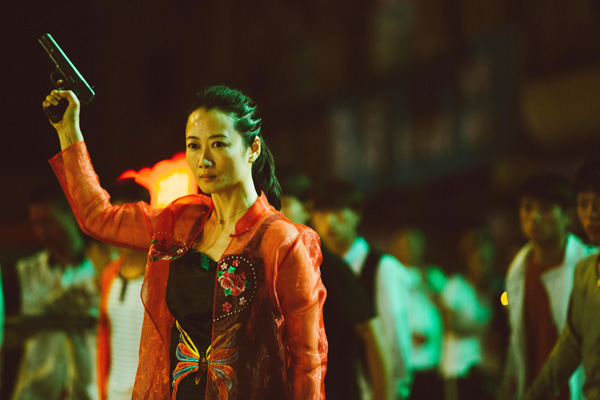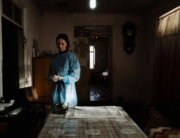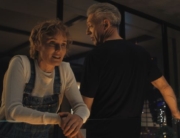It’s all in the landing.
Three films in competition at the Cannes Film Festival this year emphasize how much the last act of any film wraps up or diffuses everything that comes before it.
Pawel Pawlikowski’s intimate Cold War was consistently mentioned as a possible Palme d’Or winner after its premiere, and it went on to win Best Director. The elegant, somber film does indeed have a lot going for it: a strong evocation of time and place; sensuality oozing from the lead actors; and silvery, luscious black-and-white cinematography. It shares the stark, minimalist production design of Pawlikowski’s Oscar-winning Ida, though Cold War has a more vibrant and varied look, as it spans 10 years and many countries from 1949 to 1964, including Poland, Bosnia, and Paris.
Cinematographer Lukasz Zal (Ida) highlights to great effect the wintry, barren backdrop. As in Pawlikowski’s previous movie, the aspect ratio is the classic square-shaped 1.33:1. Narrower than wide screen, the framing emphasizes the vertical space and also confines its two protagonists and limits their options: a musical director and his protégé at a state-sponsored school to promote Polish folk music and dance. During the auditions for the first class of students, Wiktor (Tomasz Kot) singles out a blonde teenager with bangs, Zula (Joanna Kulig, who, depending on the angle, looks a lot like Jessica Chastain). The Communist Party watchdog, apparatchik Kaczmarek (Borys Szyc), also has his eye on Zula.
As the story line progresses into the early 1950s, propagandic paeans to Stalin become a mandatory part of the company’s repertoire, agrarian reform set to a rousing chorus. Meanwhile, Wiktor and Zula rendezvous in grassy fields, away from prying eyes. During this time, Kaczmarek has forced Zula to spy on Wiktor to find out about his wartime experiences and his current political beliefs. As a result of compounding pressures, an unspoken question surfaces: When should the couple make a break for the West?
The images are almost breathtaking, such as Paris by night as seen from a cruise down the Seine. However, once the love affair begins to cool, one undeveloped plot point follows another, and motivations get lost along the way as so much happens to Wiktor, a musical Jack-of-all-trades, and Zula. (The script packs in a lot of East/West intrigue.) The notion that fleeing to the West doesn’t necessarily bring happiness remains a glimmer of an idea, but one of many.
Running at a too-tight 84 minutes, this is the only film I’ve ever seen at Cannes that I wished was longer. The script gets straight to the point, though structured like bullet points in an outline. It’s as though the scriptwriters already knew the ending and forced it upon a narrative otherwise made up of lucid and compelling snapshots of Wiktor and Zula’s relationship. The result: elliptical and underwritten storytelling.
The best performance in the first eight days at Cannes was by Zhao Tao in Jia Zhang-ke’s Ash Is Purest White, a too-rare subgenre of the crime drama: the life of a gangster moll. Think of a pensive, calmer Joan Crawford vehicle, The Damned Don’t Cry. Yet this is not really crime film. Its intention is not revenge but reconciliation.
Hand on her hip, strolling by gambling tables, Qiao (Tao) oversees her boyfriend Bin’s (Liao Fan) business with a mixture of pride and coquettishness. She’s one of the boys and the only woman among a brotherhood. Like Cold War, Ash Is Purest White sweeps through history, beginning in 2001 and focusing on a familiar theme for Zhang-ke, the recent transformation of China’s industrial outskirts to the new economy, starting in the northern city of Datong, with a population of more than three million. Rumor has it that the local coal producing plant will shut down permanently. Qiao’s father will lose his livelihood.
In the first undercurrent of an impending turf war, Bin’s mentor is shot dead by a teenager. Then during a stroll in a neighborhood that has become a ghost town, Bin is whacked in the knee by a teen assailant. The press notes describe the film as a blend of genres, featuring a touch of martial arts, but that is an exaggeration. Although there is a brutal fight scene, it’s more in the style of Brian De Palma than Johnnie To. This incident turns Qiao from an obedient follower to an instigator (see the photo above, and if you are reminded of a gun-yielding Gena Rowlands in Gloria, you’re not the only one).
The central, and best, section takes place after Qiao is freed from prison in 2006 after a five-year sentence and follows her search for Bin, who is nowhere in sight when she is released. In American parlance, she’s been given the brush-off. She knows that he has moved on, but she needs him to face her and tell her himself. As in Zhang-ke’s Still Life (2006), the camera takes a cruise along with Qiao down the rising Yangtze River in the zone affected by the Three Gorges Dam Project, which has displaced more than a million people. (Needless to say, armchair travelers had a lot to take in at the festival.)
During her imprisonment, Qiao changed, having acquired a gift of the grift that was only alluded to in the beginning. The camera slowly tracks behind her, so the audience is at least one step behind her, making her day-to-day survival skills that much more compelling. In contrast to its constant threat of violence, the film also depicts simple, dare I say sweet, gestures that are even more powerful. There is a lot of stillness here in the camera work and the acting. Nevertheless, Tao doesn’t hold back. She balances understatement with full-on drama.
The movie had perhaps the best-directed sequence of the films seen in the competition, a moment of decision for Qiao: Can she really change her life? However, the stillness that was so effective earlier on grinds the film to a near-halt in the last 20 minutes, because of an imbalance. Gruff and guarded, Fan as small-time mobster Bin doesn’t hold one’s attention. His performance only hints at undercurrents. The film is strictly a one-sided affair between the audience and Qiao, thus the movie ends on a wan note.
Three years ago, actor Vincent Lindon won the Best Actor prize for Stéphane Brizé’s The Measure of a Man. They have reteamed for this year’s At War, where Lindon plays Laurent, who is, like the actor’s role in the earlier film, a man of the people, this time a factory worker and labor activist fighting for jobs in the changing French Rust Belt. (Between this and Spike Lee’s BlacKkKlansman, no one could say there wasn’t a film at Cannes that dealt directly with here and now issues).
Laurent’s German-based employer plans on cutting 1,100 jobs, breaking its previous promise that the automobile parts plant would provide employment for three more years, even though the employees had already made concessions. Taking action, Laurent and his colleagues petition the court to block the closing, and the workers lock down the plant, preventing goods from going out.
Filmed with a handheld camera, the low-simmering negotiations feel like real-life discussions, with long-winded, circular debates that go on for minutes on end. The overall directorial style is by the numbers, similar to The Measure of a Man. Though some scenes build in tension, they take a while to get there.
Though Laurent may be at the center of the debate, the focus is really dispersed throughout the workers as the conflict centers on whether they should give in to the company’s demands. The film comes off as impersonal as a result, despite the urgent debates, and it’s jarring when the narrative belatedly displaces the fate of the workers in favor of Laurent. That’s not to say the film doesn’t pack a punch. Boy, does it, but coming out of left field, it’s too little, too late.








Leave A Comment